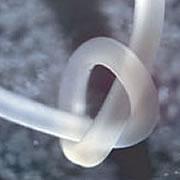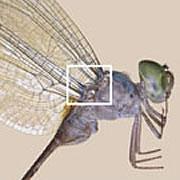 Resilin makes for super bendy materials.
Resilin makes for super bendy materials.The springy molecule that gives fleas their amazing jumping ability has been mimicked in the laboratory. The material could one day be used in anything from bouncy balls to spinal implants, hope scientists.
Resilin is a rubbery protein that is found in a range of insects. As well as storing elastic energy in fleas, it helps flying insects' wings to flex without causing damage to the tissue that connects wing and body.
“I remember running around the lab that day showing it to everybody, saying 'Here, feel this!”
Chris Elvin
CSIRO Livestock Industries in St Lucia, Australia
"Resilin is much more resilient than any other rubber around," explains Chris Elvin, a biochemist at CSIRO Livestock Industries in St Lucia, Australia, who led the team that created the synthetic resilin. This resilience means that it can be stretched over and over again without losing its elastic properties.
Rapid reaction
To make the synthetic resilin, Elvin and his team isolated a portion of the resilin gene from the fruitfly Drosophila melanogaster, and inserted it into Escherichia coli bacteria. A brew of the microbes generated several grams of the protein pro-resilin, which is a precursor to resilin itself.
The researchers then mixed pro-resilin with a ruthenium catalyst under a light, which knitted together units of the amino acid tyrosine within the molecules. After just 20 seconds the liquid mixture turned into a rubbery solid that behaved exactly like resilin itself, they report in this week's Nature1.
 Insects may need to bend their wings some 500 million times during their lives.
Insects may need to bend their wings some 500 million times during their lives.The reaction worked on the very first attempt, recalls Elvin. "I remember running around the lab that day showing it to everybody, saying 'Here, feel this!'," he laughs.
Although the gene that generates resilin in fruitflies had already been tentatively identified by other researchers2, the precise code for making resilin was not known. So the Australian scientists picked out a small section of DNA at the end of the gene that contained lots of repeating sections of code, hoping that it would make resilin.
They reasoned that as elastic proteins in nature are often made of repeating sequences of amino acids, the genes responsible for constructing them must also be repetitive. "It was a bit of a guess," admits Elvin.
Keep on flexing
"Resilin has remarkable properties," says Roderic Lakes, a materials scientist at the University of Wisconsin, Madison, "and its ability to withstand repeated flexing could be very valuable."
Elvin says that the team is dreaming up a range of applications for the material. At the moment the group is focusing its attention on using the stuff to make replacements for spinal discs, the spongy material that lies between bones in the spine.
ADVERTISEMENT
The resilin molecules in a fruitfly's wings might have to stretch about 500 million times during its life, says Elvin, and a human may flex their back a similar number of times. Using a material that can withstand a lifetime's punishment could significantly improve existing artificial spinal discs, which are made of metal and polythene.
"No-one has had these implants in their body for long enough to determine what the real lifespan of these devices is," says Barbara Boyan, a biomedical engineer at the Georgia Institute of Technology in Atlanta. "If you could find a material that is resilient over the long term, that would be a very exciting thing."
The team is studying how the material behaves inside living lab animals to find out whether it could be used in such implants.
The group is also trying to add a gene that makes spider silk to the modified E. coli, so that the rubber it produces is stronger than resilin itself while being just as stretchy. "People have been trying to do similar things with spider silk for a while," says Lakes, "and I think this approach could bear fruit."
CSIRO Livestock Industries in St Lucia, Australia
